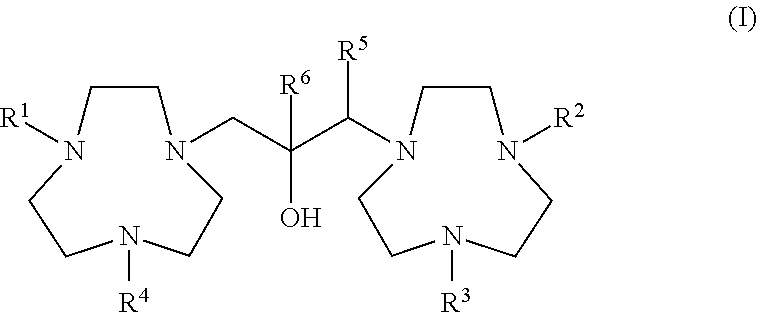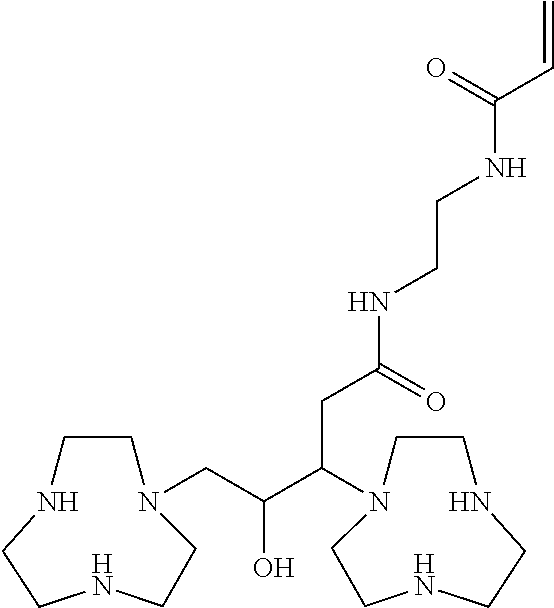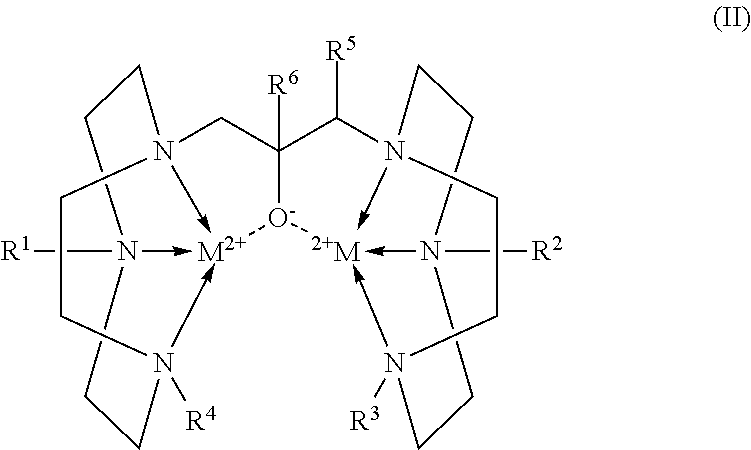Conjugates of 1,4,7-triazacyclononanes, dinuclear metal complexes of such conjugates, and methods of use for both 1,4,7-triazacyclononanes and conjugates
a technology of dinuclear metal complexes and conjugates, which is applied in the field of conjugates of 1, 4, 7triazacyclononanes, dinuclear metal complexes of such conjugates, can solve the problems of limited laboratory use utility, and achieve the effects of different absorbance or fluorescence spectrum, different positive charge dinuclear metal complexes of phosphate esters, and reduced affinity
- Summary
- Abstract
- Description
- Claims
- Application Information
AI Technical Summary
Benefits of technology
Problems solved by technology
Method used
Image
Examples
Embodiment Construction
[0007]The ligands, which are substituted or unsubstituted 1,3-bis(1,4,7-triazacyclonon-1-yl)-2-hydroxypropane, are represented by generic Formula (I):
[0008]
[0009]In Formula (I), the groups R1, R2, R3, R4, R5, and R6 are the same or different (some the same and others different) and are either H or a lower alkyl group. The expression “lower alkyl” is defined as an alkyl group of six carbon atoms or less. Preferred groups for R1 through R6 are either H, C1-C3 alkyl, or combinations selected from H and C1-C3 alkyl, and the most preferred is H. The term “substituted” in this context denotes that one or more of R1, R2, R3, R4, and R6 is an alkyl group rather than an H atom.
[0010]Ligands that are described herein as not being conjugated are those in which R1, R2, R3, R4, R5, and R6 are the same or different and each is either H or a lower alkyl group. The conjugates of the ligands are those compounds of Formula (I) in which a conjugating member occupies any of the positions indicated by R...
PUM
| Property | Measurement | Unit |
|---|---|---|
| fluorescent | aaaaa | aaaaa |
| solubility | aaaaa | aaaaa |
| mass spectrometry | aaaaa | aaaaa |
Abstract
Description
Claims
Application Information
 Login to View More
Login to View More - R&D
- Intellectual Property
- Life Sciences
- Materials
- Tech Scout
- Unparalleled Data Quality
- Higher Quality Content
- 60% Fewer Hallucinations
Browse by: Latest US Patents, China's latest patents, Technical Efficacy Thesaurus, Application Domain, Technology Topic, Popular Technical Reports.
© 2025 PatSnap. All rights reserved.Legal|Privacy policy|Modern Slavery Act Transparency Statement|Sitemap|About US| Contact US: help@patsnap.com



